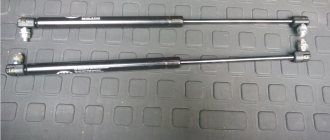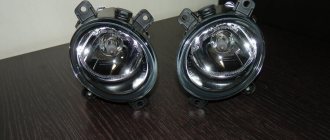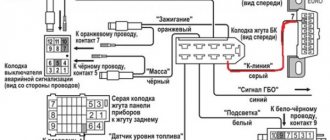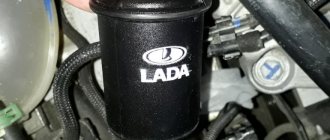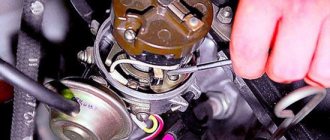All car enthusiasts know that the cost of gasoline can now significantly hit the family budget. Therefore, drivers who have at least some experience consider re-equipping the car with the installation of gas equipment as their first priority. Read about the pros and cons of this solution in the article at the link.
This allows you to significantly save on fuel, especially if the machine is used quite actively. Examples of installing gas equipment on Largus show that it pays for itself very quickly, and in a short time. In this article we will discuss the features of installing LPG on the Lada Largus and all issues related to this topic.
Features of the Lada Largus transition to LPG
LPG is designed to ensure the operation of a car on gas. From the above text the decoding is already clear. This equipment allows you to replace the traditional types of fuel provided by automakers when producing a car with a more economical one, which allows the vehicle owner to significantly reduce fuel costs.
One of the features of this system is the need to install additional units that require space for placement. This may scare off some car owners, and completely in vain. It is clear that gas cannot be in the same container with other fuel, but gas equipment can be easily mounted on any car, including Largus.
If we analyze the features of gas treatment in Largus, we can note that the gas is placed in a hermetically sealed cylinder specially designed for this purpose, which, in most cases, is placed in the trunk of a car. Since it is pumped under pressure, when it enters the reducer, it completely transitions from a liquefied to a gaseous state, from where it reaches the gas injector nozzles.
The system is designed in such a way that fuel is injected evenly with the required distribution.
Test results
The VAZ 21129 in-line 4-cylinder 16-valve engine is installed. The manufacturer claims a maximum power of 106 hp. (148 Nm) at 5800 rpm.
Let's see how the characteristics of the Lada Largus gasoline engine have changed after installing LPG.
As can be seen from the graph, when the engine speed is increased to 5200 rpm, the maximum power of the Lada Largus engine is:
- 91.9 hp on gasoline
- 93.1 hp on gas
Maximum torque:
- 138.6 Nm on gasoline
- 130.7 Nm on gas
Average torque:
- 124.4 Nm on gasoline
- 122.4 Nm on gas
The total loss of torque, inevitable when installing any LPG, was only 1.6%.
Moreover, after switching to gas, the engine of our Lada Largus became more powerful by + 1.2 hp.
For the owner, this difference in power before/after is imperceptible: to notice it, you will have to test the car on a dynamometer.
We decide on the generation of gas equipment and the manufacturer
Lada Largus is an injection car. Most experts, taking into account its characteristics and design features, agree that the installation of fourth-generation gas equipment would be most appropriate.
This equipment is of higher quality, both in manufacturing and operational parameters. It is much more reliable than its predecessors, and conversion is much easier with it. If we compare this generation of gas equipment with other similar installations, we cannot fail to mention its high efficiency. Gas consumption, when compared with gasoline, is almost equal for this equipment; there may be deviations in one direction or another of about ten percent.
You might be interested >> Gas equipment on Granta with 8 valves
It should be noted that any car enthusiast with some qualifications as an auto mechanic can easily install gas equipment in Largus. Taking into account the specifics of the domestic automobile industry, any car owner in our country, to one degree or another, is able to perform the necessary maintenance of the car on their own. This conversion is also not particularly difficult, although if you turn to experienced professionals, you don’t have to worry about the correct installation and adjustment.
Attention! Choosing the right installer will ensure high-quality installation and configuration of the system.
Which manufacturer should you choose? Equipment from Italian and Polish companies Digitronic, LPGTech and OMVL has proven itself well. The last option of the above is the most preferable in terms of quality, providing a five-year warranty service and operational reliability. But what kind of gas equipment to install on Largus is, in any case, up to the car owner to decide. The installation methods are similar - the cylinder is placed in the trunk in place of the spare tire.
Lucky or unlucky
Largus was given to me filled to capacity with both gasoline and gas. Therefore, I boldly drink to Ryazan. From the moment of refueling, almost 300 km of mileage will be accumulated, for which, as I expect, the gas cylinder will be enough. It is 90-liter and holds up to 22 m³ of methane.
I've arrived! Of the five local CNG filling stations, one is located simply ideally - right on the bypass road. The price is communist: 14.6 rubles per cubic meter of methane.
I count and don’t believe the result. At this price, a kilometer costs one ruble (if you take into account only fuel costs). Gasoline is three times more expensive! And this is on the basis that consumption per hundred will not exceed seven liters, which Largus, which has the aerodynamics of a brick, still needs to be persuaded to do.
The next point of my mini-run required luck. There is only one gas filling station in Kasimov. If it doesn’t work, it’s another hundred kilometers to go to the nearest one. She is in Murom, from where she will have to return to Moscow along the already busy Gorkovka, which is not part of my plans.
Luck is on my side again! However, the price is already 17 rubles per cubic meter, so the cost per kilometer on the second cylinder rises to 1.3 rubles. But this is also a fantastic saving compared to gasoline.
Having set a course for Moscow, I did not foresee any difficulties. The next station is already on the Moscow Ring Road, and, as experience has shown, there is just enough reserve for 300 km before it... The gas ran out literally a kilometer before the destination. But I couldn’t replenish its reserves. Two pumps, two attempts at each, half an hour of wasted time, but the fuel never arrived at Largus. What the automatic refueling didn’t like remains unknown.
The nearest CNG filling station is fifteen kilometers one way. Given the evening traffic jams, such a pastime smacks not of economy, but of idiocy, so I’m going home. And Largus is forced to travel fifty kilometers on gasoline. In a traffic jam cycle this is about five liters. Not much, but I’m focused on saving!
The following days passed in the rhythm of the city. The highway range of about 300 km was reduced to 200–220 km (depending on the number of traffic jams). The cost per kilometer reached one and a half rubles, still remaining at an abyss away from the “gasoline” (with a consumption of 10 l/100 km and refueling AI-92, this is 4.2 rubles per kilometer).
Pros and cons of switching to LPG on the Lada Largus
Installing HBO on Largus with 16 valves has both its pros and cons. The benefits include:
- reduction of carbon deposits on internal engine parts due to the greater purity of gas fuel compared to more traditional ones;
- saving fuel and the cost of its acquisition;
- increased engine life due to more complete combustion of gas;
- reduction of background noise during operation of the power plant;
- increased environmental friendliness.
Note! Gas fuel is highly environmentally friendly and reduces the noise level when the engine is running.
The negative aspects are as follows:
- the need for financial investments for the purchase and installation of gas equipment;
- it will be necessary to re-register documents for the car with state regulatory authorities because the type of fuel used changes;
- insufficient number of gas stations selling gas;
- the danger of this fuel;
- increased load on the fuel pump and the entire power system.
Read what the fine is for gas equipment without documents.
Some of these shortcomings are not particularly important, since the converted vehicle has a significant mileage without refueling, and the reliability of the design makes it possible to neutralize the possible explosion hazard of this type of fuel.
What's the secret?
Of course, such brilliant results are impossible without choosing reliable Italian equipment from Landi Renzo .
We have been working with the manufacturer Landi Renzo for 20 years. And all these years we have only become more convinced of our choice and the reliability of this brand.
So for our Lada Largus we chose the 4th generation Landi Renzo EVO kit.
Very little effort and time is spent on installation, and then, like in a fairy tale: I sat down and drove off. No additional work, settings, rechecks - only economical, quiet and efficient operation of the engine on gas.
Landi Renzo EVO kit is easy to install, has a self-calibration function, and is suitable for our climate and gas: propane-butane mixture, which is sold at Belarusian gas stations.
- After installing Landi Renzo EVO on a car, the environmental friendliness of the exhaust increases by one class. In our example, the Lada Largus complied with Euro-5 eco-standards, but now it complies with Euro-6.
- The reducer is designed for use in propane-butane systems, contains a solenoid shut-off valve for greater safety and is suitable for 4-cylinder engines up to 110 kW.
- Italian gas injectors are considered the best among competitors; they are resistant to various fuel contaminants and have a long service life.
- The petrol/gas switch, which is installed in the passenger compartment, will not only fit well into any car interior, but will also show the level of remaining gas in the cylinder, and when the fuel level is low, it will sound a reminder to the driver.
Another secret of our result in converting Lada Largus to gas is the firmware, due to which the electronic engine control unit supplies fuel to the cylinders so that the engine does not actually lose power. As was the case in our case.
Do you want the same?
Our experience in converting the Lada Largus to gas, the ECU firmware used and high-quality Italian equipment - all this suggests that any car produced by AvtoVAZ with a 1.6 petrol engine can be converted to gas without any actual loss of power. After all, a 1.6% loss of torque will not in any way affect the speed gain and driving comfort.
Do you want to reduce fuel costs and avoid detonation and coking of engine cylinders, and switch to environmentally friendly and inexpensive fuel - gas?
Then welcome to the installation of gas equipment in.
The first 50 owners of cars manufactured by AvtoVAZ receive a 2-year warranty on the installed gas equipment without mileage restrictions.
- See photo reports of our other works in the gallery.
Operating principle and choice of generation. Reviews from car owners
Factor Propane Methane Price Low High Price relative to gasoline Almost 2 times less Three times less Consumption relative to 10 liters of gasoline No more than 11.5 liters Up to 8.5 cubic meters Cylinder weight Up to 30 kg Up to 125 kg Cruising range Up to 1000 km No more than 350 km Compression Up to 15 atmospheres Up to 250 atmospheres Negative impact on the engine High Low Octane number 100 110 Environmental friendliness High Complete safety Drop in engine power 5 Up to 30. Transmission type Average consumption per 100 km, l Fuel consumption LADA Largus 1st generation 2012 1.6 84 manual transmission 8.1-8.6 Unleaded gasoline AI-92 87 manual transmission 8.2-8.7 102 manual transmission 7.8-8.3 105 manual transmission 7.8-8.4 106 manual transmission 7.9-8.5 LADA Largus modification R90 1.
| Body type | City | Route | Mixed |
| Station wagon 7 seats, 16 cl. (K4M) | 9,8 | 6,3 | 7,5 |
| The same, 8th grade. (K7M) | 10,5 | 6,5 | 8,0 |
Briefly about the design of the Lada 21129 16 valve engine
The need to use EURO 5 class internal combustion engines on new Lada models forced the management of the AvtoVAZ concern to once again modernize its 1.6-liter 16-valve unit. Taking 21127 as a basis, the engineers changed the intake, clamped the exhaust, and filled it with new firmware.
Since the unit is now placed on a subframe, the supports and oil pan have been slightly redesigned. Adaptation has also been made for the installation of an alternative French JR5 gearbox.
Equipment selection
Among the popular manufacturers of gas equipment, these are the brands that are most often found on the market:
- Lovato. The Italian manufacturer has established itself in the European market, and its products are also highly rated in the CIS. A distinctive feature is that the equipment is produced in an aluminum sealed block - so it is reliably protected from moisture. Systems from Lovato offer the optimal price-quality ratio. The equipment includes a complete set, high-quality electronics are noted. The brand has been represented on the Russian and CIS markets for a long time, so there are no problems with spare parts. Structurally, there is nothing complicated in the HBO from Lovato, so it is inexpensive and reliable. Among the shortcomings, there are failures in the operation of the gearbox at low temperatures. Spare parts are cheap, but repairs are relatively expensive. Units are rarely repaired, since it is cheaper to replace them as an assembly. There are also many fakes on the market.
- PRINS. The Dutch company, which has been in the gas equipment market for 25 years, was in fact at the origins of the production of gas equipment for cars. The products are of high quality and are constantly being modernized. The brand is elite in its own way, so the prices are high.
- STAG. The Polish company is one of the five best manufacturers of electronics for gas equipment. The list of products includes equipment sets and components for them. STAG focuses on quality and long service life, low prices and ease of operation. Equipment with a Russified menu is produced for Russia.
- ATIKER. Company from Turkey. LPG complies with European standardization standards ISO 9001:2000 and is certified ECE R 67-01. All products are necessarily tested and tested. Their main feature is good quality at an attractive price. Having the appropriate licenses, the company copies equipment from famous Italian manufacturers. The product list includes complete HBO sets, which are attractive with their low price. Among the shortcomings, the quality of components is not the best, so repairs are required more often. The rubber elements of the system wear out faster.
The world-class Italian company BRC produces high-quality products and gives them a long guarantee. According to representatives of the company, the LPG system can last at least 300 thousand kilometers without failures. All components are manufactured in one plant, which ensures perfect consistency. But on the Russian market, BRC products are one of the most expensive, the dealer network is poorly developed, and problems may arise with the acquisition of original spare parts.
